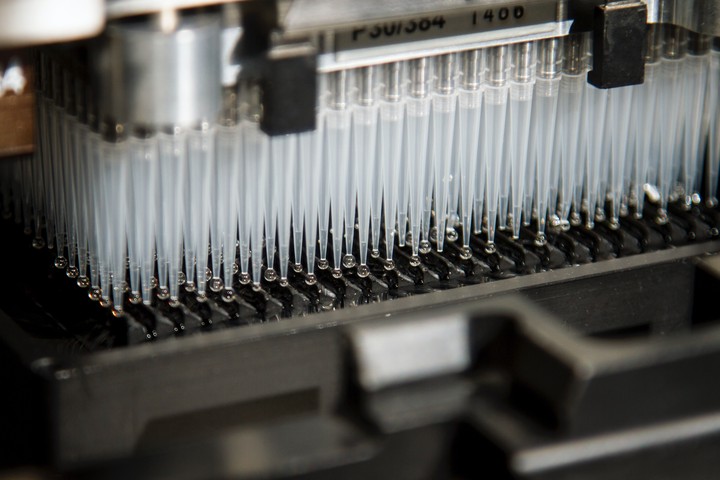Using Limma to find differentially expressed genes
 Photo by
National Cancer Institute on
Unsplash
Photo by
National Cancer Institute on
UnsplashRitchie, ME, Phipson, B, Wu, D, Hu, Y, Law, CW, Shi, W, and Smyth, GK (2015). limma powers differential expression analyses for RNA-sequencing and microarray studies.Nucleic Acids Research 43(7), e47.
limma is an R package hosted on Bioconductor which finds differentially expressed genes for RNA-seq or microarray. Recently I’ve been working on a PCR-based low-density array and noticed that I forgot how to use limma for the one hundredth time, so I decided to make a note.
Preparation
- Log-transformed expression data in a matrix:
Each column represents an experiement, and each row represents a detected gene/probe. - Design matrix:
Each column represents a status of your data (e.g., wild-type, mutant, rescued…), and each row corresponds to an experiment in the expression matrix. This could be generated from anexpressionDatasetobject, or we could create this manually if you only have a raw expression dataset like me. - Contrast matrix: Specified a set of parameters to specify the contrasts being compared later.
library(limma)
# Create a dummy expression matrix
exp_matrix <- data.frame(sample_1 = c(3, 3, 2, 2, 1),
sample_2 = c(3.2, 2.8, 2, 2, 1.3),
sample_3 = c(1, 1, 2, 2.3, 5),
sample_4 = c(1.1, 0.9, 2, 2, 4),
sample_5 = c(2.5, 2.5, 2, 2.5, 2),
sample_6 = c(2.6, 2.3, 2.1, 2.2, 1.8),
row.names = paste("gene", seq(5), sep = "_"),
stringsAsFactors = FALSE)
print(exp_matrix)
## sample_1 sample_2 sample_3 sample_4 sample_5 sample_6
## gene_1 3 3.2 1.0 1.1 2.5 2.6
## gene_2 3 2.8 1.0 0.9 2.5 2.3
## gene_3 2 2.0 2.0 2.0 2.0 2.1
## gene_4 2 2.0 2.3 2.0 2.5 2.2
## gene_5 1 1.3 5.0 4.0 2.0 1.8
# Create a design matrix
design <- model.matrix(~ 0+factor(c(1,1,2,2,3,3)))
colnames(design) <- c("Wild_type", "Mutant", "Rescue")
print(design)
## Wild_type Mutant Rescue
## 1 1 0 0
## 2 1 0 0
## 3 0 1 0
## 4 0 1 0
## 5 0 0 1
## 6 0 0 1
## attr(,"assign")
## [1] 1 1 1
## attr(,"contrasts")
## attr(,"contrasts")$`factor(c(1, 1, 2, 2, 3, 3))`
## [1] "contr.treatment"
# Create a design matrix to indicate the comparisons to make by limma
cont_matrix <- makeContrasts(MutvsWT = Mutant-Wild_type,
MutvsRes = Mutant-Rescue,
levels=design)
print(cont_matrix)
## Contrasts
## Levels MutvsWT MutvsRes
## Wild_type -1 0
## Mutant 1 1
## Rescue 0 -1
Analysis
Now, I am pretty much ready (except for the need to understand the math).
# Fit the expression matrix to a linear model
fit <- lmFit(exp_matrix, design)
# Compute contrast
fit_contrast <- contrasts.fit(fit, cont_matrix)
# Bayes statistics of differential expression
# *There are several options to tweak!*
fit_contrast <- eBayes(fit_contrast)
# Generate a vocalno plot to visualize differential expression
# Highlighting the top 2 genes
volcanoplot(fit_contrast, highlight = 2)

# Generate a list of top 100 differentially expressed genes
top_genes <- topTable(fit_contrast, number = 100, adjust = "BH")
print(top_genes)
## MutvsWT MutvsRes AveExpr F P.Value adj.P.Val
## gene_1 -2.05 -1.50 2.233333 205.9703070 2.448629e-05 0.0001224315
## gene_2 -1.95 -1.45 2.083333 145.5778494 5.515948e-05 0.0001378987
## gene_5 3.35 2.60 2.516667 49.9796088 6.486868e-04 0.0010811446
## gene_4 0.15 -0.20 2.166667 2.6155372 1.715306e-01 0.2144132510
## gene_3 0.00 -0.05 2.016667 0.2942966 7.577324e-01 0.7577323813
# Summary of results (number of differentially expressed genes)
result <- decideTests(fit_contrast)
summary(result)
## MutvsWT MutvsRes
## Down 2 2
## NotSig 2 2
## Up 1 1